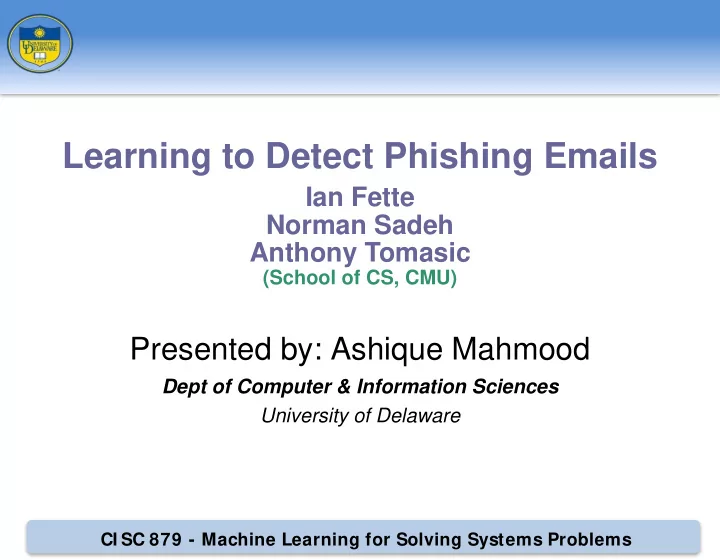

Learning to Detect Phishing Emails Ian Fette Norman Sadeh Anthony Tomasic (School of CS, CMU) Presented by: Ashique Mahmood Dept of Computer & Information Sciences University of Delaware CI SC 879 - Machine Learning for Solving Systems Problems
Key Terms • Learning (= Machine Learning) • Classifier, training data, testing data, model etc. • False positive, False negative • Phishing attacks Trying to direct web users to spoofed websites that steal information such as credit card, Identity info, SSN, passwords etc. Most popular way to “phish” is E-mail. CI SC 879 - Machine Learning for Solving Systems Problems
Key Terms (contd.) • Phishing attacks An Example: “ We Recently Upgraded Our Security System with a Newly Established SSL Sever In which Guarantees your maximum Security Protection when Accessing Your Webmail account Online. Click here to Upgrade Regards, University of Delaware Security Department ” (March 17, 2010) CI SC 879 - Machine Learning for Solving Systems Problems
Key Terms (contd.) • Phishing attacks CI SC 879 - Machine Learning for Solving Systems Problems
Early attempts • Toolbars Integrated to browsers, prompt user with warning. Can have up to 85% of success. • Disadvantage: • Less contextual information • Users may dismiss or misinterpret warning • Loss of productivity CI SC 879 - Machine Learning for Solving Systems Problems
Spam Detection vs Phishing detection • Why phishing detection is different from spam detection? • Spam Detection - • focuses on the structure/subject of the email. • looks at the vocabulary of the email, suspicious words. • Blacklisted senders. • Phishing emails look like legitimate. CI SC 879 - Machine Learning for Solving Systems Problems
Motivation • Phishing emails and websites are identical to legitimate ones; hence difficult to detect. • Spam filters are not good for phishing detection. • Toolbar based detection not effective and sufficient. • So, we need more sophisticated filters for phishing detection, prohibiting phishing emails reaching to inbox. CI SC 879 - Machine Learning for Solving Systems Problems
Overall approach (PILFER) 10-fold cross validation Feature Dataset Extraction Testing ( Mix of “clean” and ( using scripts) Training “phishing” emails ) -------------- -------------- (with one- (Decision tenth of the Tree) dataset) Training the model and testing - together 10-fold Cross-validation : The dataset is divided into 10 distinct parts. Each part is Tested using the other 9 parts as training data. CI SC 879 - Machine Learning for Solving Systems Problems
Dataset • Two publicly available datasets: • The Ham Corpora (SpamAssassin project) 6950 non-phishing, non-spam “ham” emails • Phishingcorpus approx. 860 “phishing” emails. CI SC 879 - Machine Learning for Solving Systems Problems
Features • Binary features: • Is it an IP-Based URL? Ex: http://192.168.0.1/ebay.cgi?fix_account • Age of linked-to domain names WHOIS query, to detect for how long the domain was active • Non-matching URLs <a href=“badsite.com”>paypal.com</a> • “here” links to non-modal domain Non-modal : not the most frequently linked domain CI SC 879 - Machine Learning for Solving Systems Problems
Features(cont’d) • Binary features: • HTML emails? MIME type text/html indicates possible phishing attack • Contains javascript? does the string “javascript” appears in the email? • Spam-filter output Output from stand-alone spam-filters is also a feature, which indicates “ham” or “spam”. (SpamAssassin is used for PILFER) CI SC 879 - Machine Learning for Solving Systems Problems
Features(cont’d) • Continuous features: • No. of links No. of links in HTML part, defined as <a> tag • No. of domains Count of how many distinct domains are present in the email, starting with http:// or https:// • No. of dots in URL Maximum no. of dots contained in any of the links. http://www.my-bank.update.data.com http://www.google.com/url?q=http://www.badsite.com CI SC 879 - Machine Learning for Solving Systems Problems
SpamAssassin • SpamAssassin • Widely used, freely-available spam filter • Highly accurate in classifying spams • SpamAssassin also tested, both • Trained • Untrained • SpamAssassin compared with PILFER. CI SC 879 - Machine Learning for Solving Systems Problems
Results • PILFER • Overall accuracy of 99.5% • False positive rate, fp= 0.0013 (approx.) • False negative rate, fn= 0.035 (approx.) CI SC 879 - Machine Learning for Solving Systems Problems
Results (cont’d) v CI SC 879 - Machine Learning for Solving Systems Problems
Results (cont’d) CI SC 879 - Machine Learning for Solving Systems Problems
Results (cont’d) v CI SC 879 - Machine Learning for Solving Systems Problems
Results (cont’d) CI SC 879 - Machine Learning for Solving Systems Problems
Conclusion • PILFER is exhibits almost accurate results, because it exploits few unique features that spam detectors don’t use. • Phishing detection along with spam detection provides best results. • Future direction: • Phishing techniques evolve over time very quickly, so continuous research expected. CI SC 879 - Machine Learning for Solving Systems Problems
That’s all, folks! Questions ??? CI SC 879 - Machine Learning for Solving Systems Problems
That’s all, folks! Thank you. CI SC 879 - Machine Learning for Solving Systems Problems
Tiny Appendix • False positive rate , ham phish fp = + ham ham phish ham • False negative rate , phish ham fn = + phish phish ham phish CI SC 879 - Machine Learning for Solving Systems Problems
Recommend
More recommend